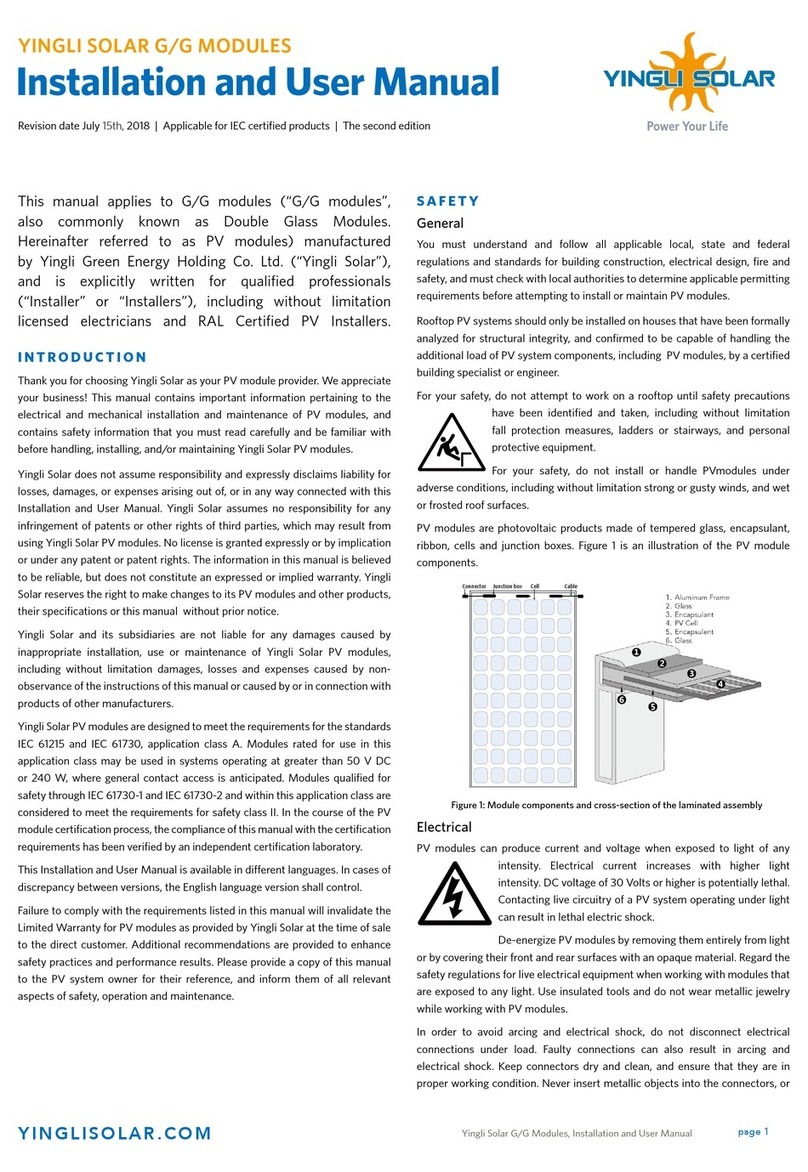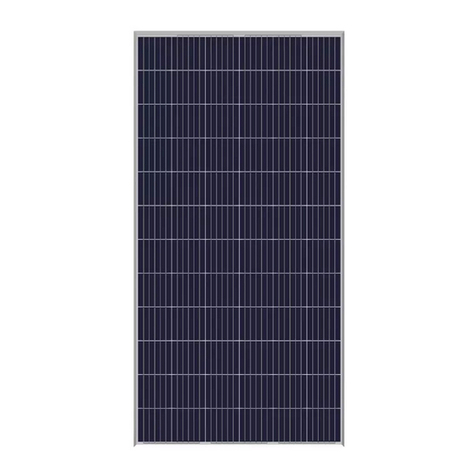
Yingli Solar PV Modules, Installation and User Manual page 2
De-energize PV modules by removing them entirely from light or by covering
their front surface with an opaque material. Regard the safety regulations for
live electrical equipment when working with modules that are exposed to any
light. Use insulated tools and do not wear metallic jewelry while working with
PV modules.
In order to avoid arcing and electrical shock, do not disconnect electrical
connections under load. Faulty connections can also result in arcing and
electrical shock. Keep connectors dry and clean, and ensure that they are in
proper working condition. Never insert metallic objects into the connectors, or
modify them in any way in order to secure an electrical connection.
Do not touch or handle PV modules with broken glass, separated frames or
a damaged backsheet unless the PV modules are first disconnected and you
are wearing proper PPE. Avoid handling PV modules when they are wet unless
cleaning the PV modules as directed in this manual. Never touch electrical
connections that are wet without protecting yourself with insulated gloves.
Transport and Handling
Yingli Solar PV modules must be transported in the supplied packaging only and
kept in the packaging until they are ready to be installed. Protect pallets against
movement and exposure to damage during transportation. Secure pallets from
falling over. Do not exceed the maximum height of pallets to be stacked, as
indicated on the pallet packaging. Store pallets in a cool and dry location until
the PV modules are ready to be unpackaged.
Figure 2: Pallet of PV modules
Yingli Solar PV modules are heavy, and should be handled with care. PV modules
shall be handled at the frame; never use the junction box or cables as a grip. Do
not exert mechanical stress on the cables. Never step on PV modules or drop
or place heavy objects on them. Be careful when placing PV modules on hard
surfaces, and secure them from falling. Broken glass can result in personal injury.
PV modules with broken glass cannot be repaired and must not be used. Broken
or damaged PV modules must be handled carefully and disposed of properly.
For unpacking PV modules from the Yingli Solar supplied packaging, first remove
the pallet lid (after removing securing straps, if provided). Remove PV modules
one at a time by sliding them up the channel in the package (see Figure 3). You
may need to secure the remaining PV modules in the pallet packaging to prevent
them from falling over.
Figure 3: Removing PV modules from a pallet
Check PV modules for damage due to transportation before they are installed;
do not install damaged modules. Contact the company you purchased the Yingli
Solar PV modules from in order to obtain information on making claims for
defective PV modules.
PV module surfaces are susceptible to damage that could aect the performance
or safety of the PV module; do not damage or scratch the PV module surfaces,
and do not apply paint or adhesive to any of the surfaces, including the frame.
For your safety, do not disassemble or modify Yingli Solar PV modules in any
way. Doing so may degrade performance or cause irreparable damage and will
void any applicable warranties.
If it is necessary to store PV modules prior to installation, the PV modules
should remain inside the packaging and protected from exposure that could
compromise the durability of the packaging.
Fire
Yingli Solar PV Modules have a Class C fire resistance rating in accordance with
the IEC 61730-2 certification. When PV modules are mounted on rooftops, the
roof must have a fire resistant covering suitable for this application. PV modules
are electrical generating devices that may aect the fire safety of a building.
The use of improper installation methods and/or defective parts may result
in the unexpected occurrence of an electrical arc during operation. In order to
mitigate the risk of fire in this event, PV modules should not be installed near
flammable liquids, gases, or locations with hazardous materials.
In the event of a fire, PV modules may continue to produce a dangerous voltage,
even if they have been disconnected from the inverter, have been partly or
entirely destroyed, or the system wiring has been compromised or destroyed. In
the event of fire, inform the fire crew about the particular hazards from the PV
system, and stay away from all elements of the PV system during and after a fire
until the necessary steps have been taken to make the PV system safe.
APPLICATION INFORMATION
Application Restrictions
Yingli Solar PV modules must be mounted on appropriate mounting structures
positioned on suitable buildings, the ground, or other structures suitable for PV
modules (e.g. carports, building facades or PV trackers). PV modules must not
be mounted on moving vehicles of any kind. Yingli Solar PV modules must not
be installed in locations where they could be submerged in water.
Yingli Solar PV modules must not be sited in locations where aggressive
substances such as salt or salt-water, or any other type of corrosive agent, could
aect the safety and/or performance of the PV modules. Although some types
of Yingli Solar PV modules have passed the IEC 61701 salt-mist corrosion test
with a salt concentration of 5% by weight, galvanic corrosion can occur between
the aluminum frame of the PV module and mounting or grounding hardware if
such hardware is comprised of dissimilar metals. Yingli Solar recommends that
only stainless steel and aluminum metal directly contact PV modules in seaside
installations to limit corrosion.
Artificially concentrated light must not be directed on Yingli Solar PV modules.
Design Recommendations
Yingli Solar recommends that PV modules be mounted at a minimum tilt angle
of 10 degrees to allow for proper self-cleaning from normal rain showers.
Partial or complete shading of a PV module or modules can significantly reduce
system performance. Yingli Solar recommends minimizing the amount of shade
throughout the year to increase the amount of energy produced by the PV
modules.
Lightning protection is recommended for PV systems that are to be installed in
locations with high probability of lightning strikes.
High system voltages could be induced in the event of an indirect lightning
strike, which could cause damage to PV system components. The open area of
wire loops should be minimized, as shown in Figure 4, in order to reduce the risk
































